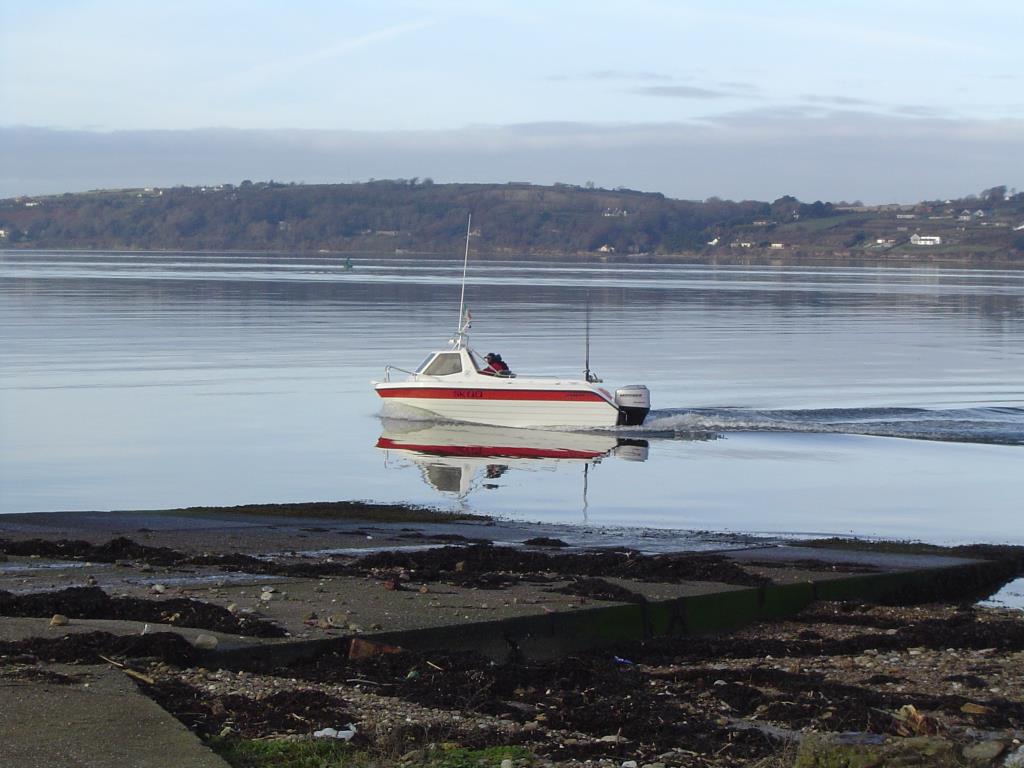In a piece that featured in Irish Angler Magazine in 2003 - The first installment of the magazine!

Bank Fishing for Blondes.
Jim Clohessy takes a trip to Cork’s “Turbot Bank”, one of the most famous banks on the south coast and home to, among others : The Blonde Ray.The mighty Raja Brachyura
Cork Harbour is the second largest natural harbour in the world. The huge expanse within the harbour offers some of the most diverse fish rich waters available to the angler. The sheltered waters offer all year round action and all year round protection. The diverse range of species within has made Cork Harbour something of a Mecca for small boat anglers from home and abroad.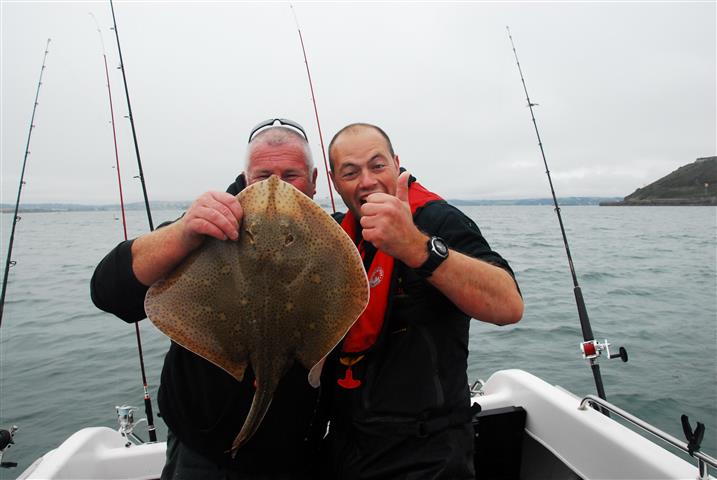
Roche’s point marks the outer reaches of the harbour. Between the twin forts of Camden & Carlisle and Roche’s Point, near buoy six, lies the Turbot Bank. The bank holds a rich diversity of fish life. The current Irish records for blonde ray, turbot, homelyn ray, dab and grey mullet were all caught in Cork Harbour. Most of these fish were caught on the Turbot Bank. Most years specimen plaice & bass are taken on the bank.
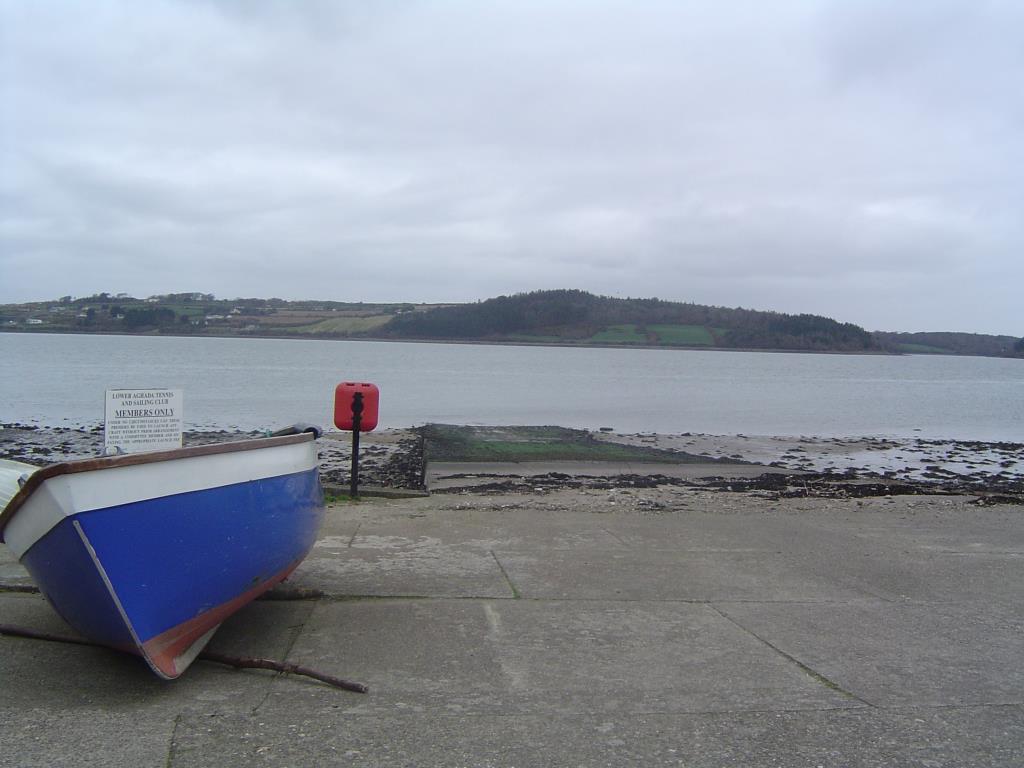
The slipway In Aghada is a shallow gradient but a nice launch
The Blonde Ray:
Growing to over forty pounds the blonde ray offers tremendous sport to the angler. The current specimen weight stands at 25lb. The current Irish record, 36lb 8oz, dates back to 1964 and was caught in Cork Harbour.(2016 edit: Paul Tennant from Cobh broke the record with a 37lb fish) We are told that they feed on small fish and crustaceans. They breed during the summer months, eggs are laid in the familiar “mermaid’s purse”. It is clear that blondes have been present in Cork Harbour for a long time however the science community believes that because of commercial pressure on other species such as plaice and turbot that the blonde population is increasing in areas where less competition exists. Sadly turbot are extremely rare on the bank.

Aghada Slipway at low water
The Bait.
Blonde rays will take a variety of baits but by far the most successful are mackerel and squid. Today we carry frozen mackerel and frozen squid.
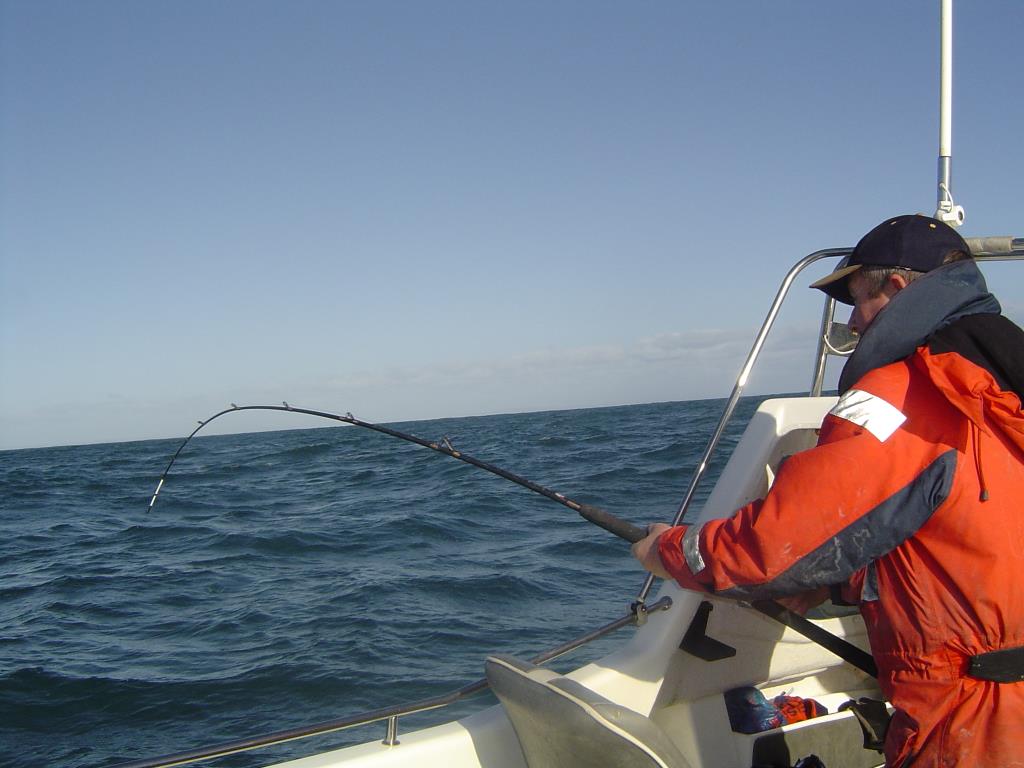
Getting the bend in!
The Tackle.
A simple ledger is the order of the day. About two to three feet long with a good quality 6/0 hook making up the business end, the preferred being a long shank pattern like Mustad’s 3261 Aberdeen. A steel wire trace is not necessary but 100lb mono is advisable as the blonde has immensely powerful jaws with rough pads that can wear through mono quite quickly. Weights are dependant on the tide. You need just enough to hold bottom but you need to be able to trot your bait if needed. Rods need not be too stiff. A 6 to 10oz uptider is plenty but a 10lb class will do if care is taken. Reels ideally should be in the ABU 7000 / PENN525/535 class needless to say packed with braid.
The fishing
I tow SKUA to Aghada on a crisp January morning. The launch goes smoothly from the wide slip at the tennis club. The slip formed part of a sea plane base during the First World War and is wide enough to accommodate three boats abreast. While our quarry is Blonde Ray but to take up the time between fish we hope to target Whiting, something for the table. There is an unofficial catch and release policy for blondes in Cork Harbour. This policy seems to be adhered to by most if not all anglers.
The trip from Aghada to the bank is taken at a brisk thirty Knots. GPS is not necessary to get to the bank but a fish finder is a necessity to position properly on the bank. As the tide is dropping we take up position in order to fish down the outside of the bank. Either a Plough, Bruce or Danforth anchor is a must to hold firmly in the sand as there is a good rip of tide especially on spring tides.

Buoy 6 in Cork Harbour marks the outer region of the Turbot Bank
The Sport:
We begin fishing, baiting up with squid. An eight ounce lead is sufficient on the day. Much has been written on the best stage of tide required to catch blondes. We have caught on all stages of tide both springs and neaps. This morning happens to be a neap tide with about three hours to high water. Within ten minutes the first telltale bite occurs. Patience is required at this stage. Usually the first “bite” from a blonde ray comes from the fish settling onto the bait. To strike now will only pull the bait away from the fish. There is a fine line between striking to early or late. Early equals no fish, late means a ray that will probably be gut hooked or wrapped around the trace and with have the fighting qualities of an open canvas bag in a four knot tide!
I strike and the first ray begins it’s journey to the net. The blonde is a super fighter, a wily adversary who will use it’s weight and wings to its advantage in the tide. Initially the biggest problem is to get the fish off the bottom. Steady pressure is needed but care must be taken, line break is very possible at this stage. Once the fish is moving it must be kept moving as quickly as possible as it will inevitably take some lunging dives for the bottom. The unprepared angler can loose the fish at this stage. Reel drag must be smooth and set lightly. Adjustment of the drag must take place all the while the fight is ongoing.
My ray took three runs before being netted. Safely onboard she weighed in at a respectable 18lbs. More rays followed in the next hour, fine fish to 22lbs.
A brisk bite followed by a telltale run announced the arrival of another ray. When they run like this the strike is barely necessary. Quickly l lift the rod and firmly set the hook. Immediately I knew I into a big fish. Applying steady pressure, adjusting drag constantly, the fish comes to the side of the boat. As we were both into fish I had to hand lift the ray into the boat. My heart skips a beat, without fail the elusive specimen!
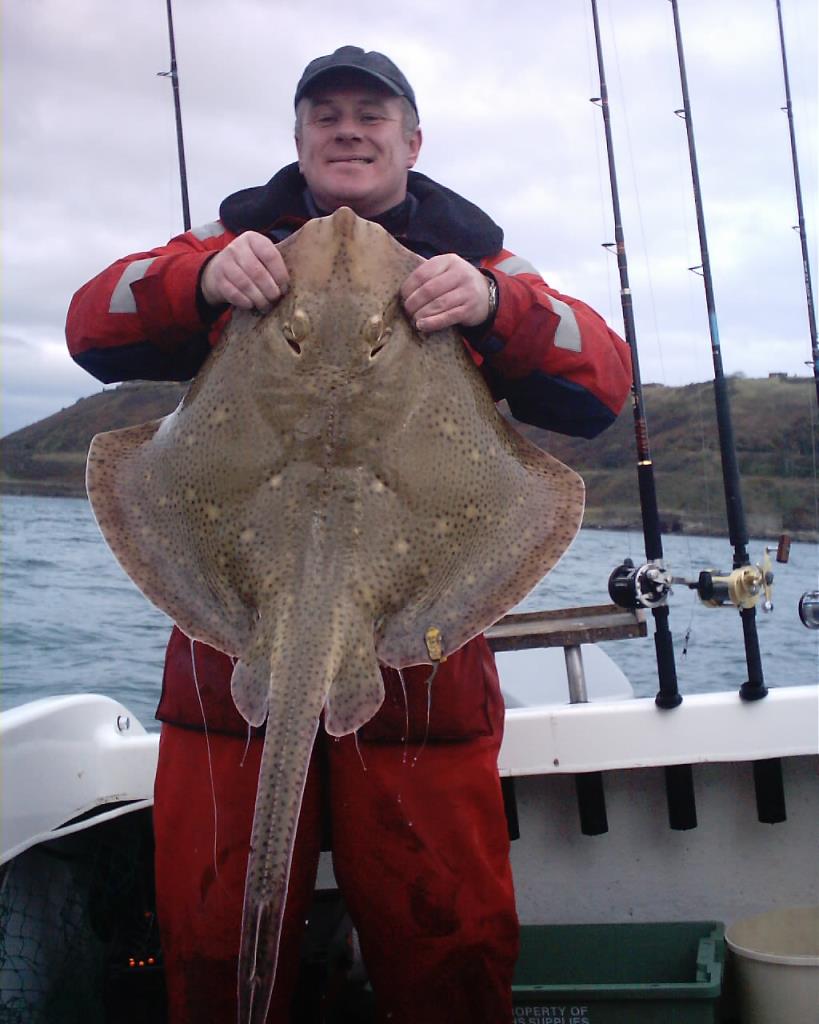
A long time coming! A specimen blonde ray
A preliminary weigh on board confirms the ray to be a specimen. The Specimen Fish Committee are very specific about the necessity to weigh specimen fish on land so we weigh anchor and head off to Crosshaven to weigh, measure and photograph the fish. Warrior Boats include a neat design feature in their 175: A fish hold. We fill this with water and the Ray is kept in good condition during the trip. Officially confirmed weight 28lb 4oz.
The fish has a tag fitted to it’s anal fin. There has been a tagging programme ongoing for some years. Charter skippers and some small boat anglers have been tagging and recording rays. We have tagged many ourselves and never have we caught a ray we have tagged! Later communication with the Central Fisheries Board shows my ray as having been tagged in 2002 weighing 19lb.
We head back out from Crosshaven to the area where the specimen was caught and release the ray unharmed.
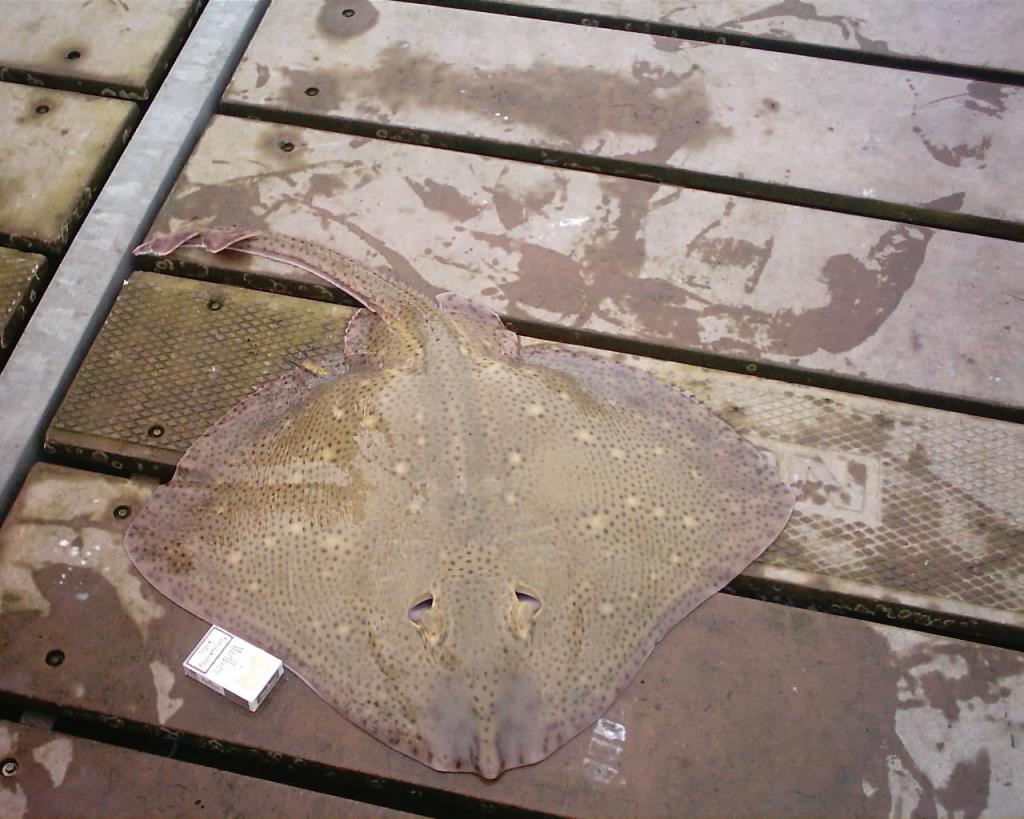
Caught, measured, weighed and released – The usual treatment for a specimen blonde ray.
Experience shows that fishing for rays over slack water is unproductive. We take the time to bag up on some whiting. Whiting offer good winter sport as well as being a nice eating fish. If we had a greater range of bait we would try for some flatties but we still manage some nice dab on mackerel. While drifting the bank we pick up a mackerel quite unbelievable for January! The fresh bait is most welcome.
As the tide is now dropping we anchor again this time fishing to the base of the bank. Within minutes we be hit some small blondes. I have a second rod out for flats, a lovely 8lb class Diawa. I see the tip bend over due to a tentative bite. As I am tackled with a two hook ledger, 1/0 hooks baited with fresh mackerel strips I immediately think of plaice. The bank turns in specimen plaice each year. I lift the rod and strike. Another ray. It became clear from the outset that this is a good fish, however with the light gear there is no possibility of bullying the fish. The ray uses every trick in its armoury, diving, kiting, sticking to the bottom, using the tide to aid the fight. Eventually, after a punishing fifteen-minute battle, the ray comes to the boat. Unbelievable, another specimen! After years chasing, to end up with two specimens in the one day, indescribable! Another trip to Crosshaven the fish weighs in at 28lb 14oz. After the usual weighing, measuring and photographing the big female is released alive at the place of capture.
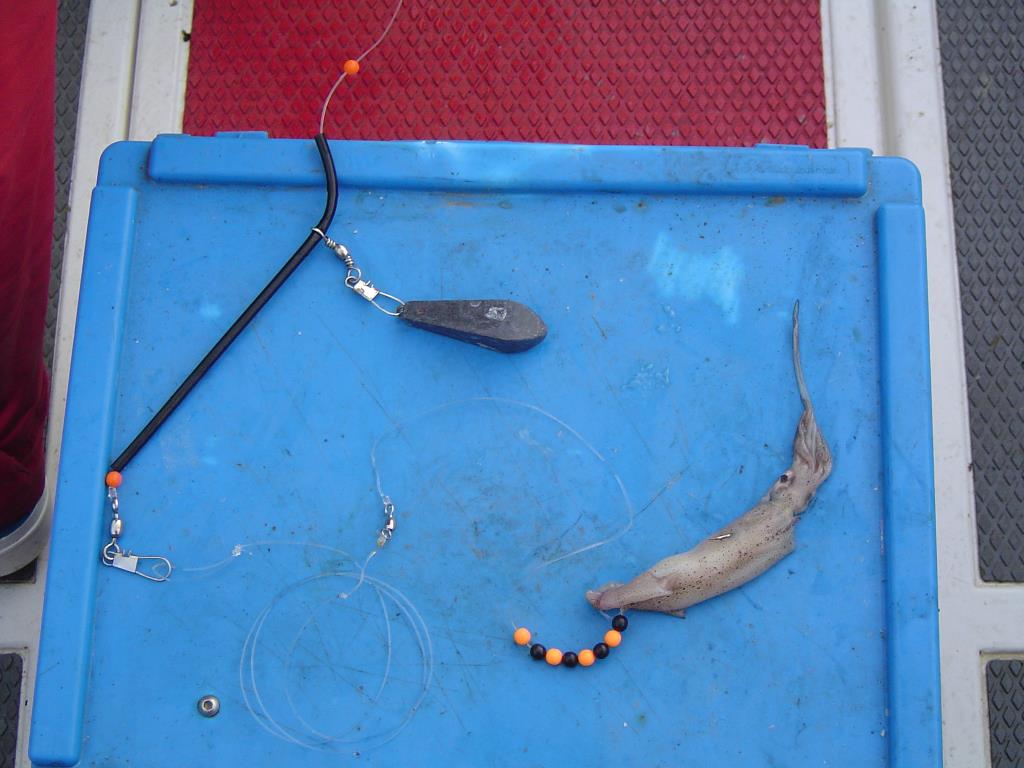
Heavy duty gear is needed to take on a big blonde. Chose between squid and mackerel for bait
An end had come to our days angling on the Bank. The return trip to Aghada was exhilarating but uneventful. We trailered the boat, completed the cleanup, filleted the Whiting and as would be fitting on a super days fishing we adjourned for a celebratory beverage.
The aftermath.
If the days fishing described here happened in August no one would be surprised. It must be remembered that this was the start of January. Our sport is a three hundred and sixty five day sport. There are many places around the country that produce good fishing in the winter. Many small boat owners put their boats in dry dock for the winter, why? The tactics discussed are the same in summer as winter. There is no doubt that the conditions are tougher and the days have to be shorter as a result, but with modern clothing, a good quality flask and an insulated cup winter fishing can be just as rewarding as the long hazy days of summer!
2016 Update:
Over the past number of years the amount of blonde rays has decreased. The Bank was netted by some short sighted commercials a good few years back and it is taking time for the bank to recover. The tactics remain exactly the same. Little has changed in terms of bait and tackle since this article was written. Timing and location on the Bank has become more important as there are less rays around. The sessions of fairly non-stop ray action are rare. Catching a few is a decent bonus.
They are a worthy target still. The fight is something that stays with you as these are an active and powerful fish.

Irish Angler featured Cork Harbour Blondes again in 2006
